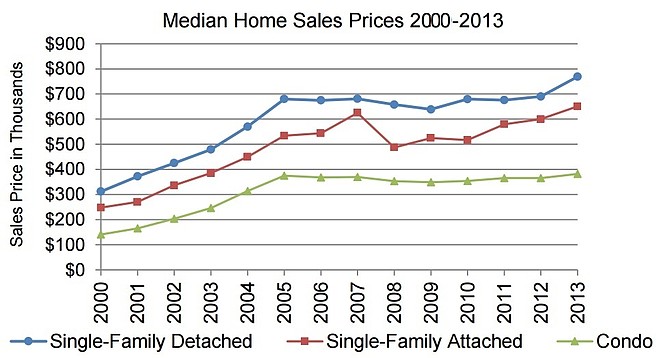A new Affordable Housing Master Plan released in March laid out Arlington County’s dire Affordable Housing needs. Hoping for approval before the plan is brought to the County Board in July, the Affordable Housing Study Working Group presented its findings to the Transportation Commission on April 2. The Master Plan was approved unanimously.
Arlington has seen a reduction in lower income households over the past decade. Between 2000 and 2012, there was a 9.9 percent reduction in households earning less than $60,000 and a 5.8 percent decrease in households earning between $60,000 and $99,000. Every income group over $100,000 saw a population increase, including a 59.8 percent increase in households earning above $200,000. In that time, Arlington also lost 13,500 affordable rental homes through rent increases, conversion to condominiums, and redevelopment.
However, between 2010 and 2040, the Arlington Affordable Housing Master Plan indicates that households with less than 60 percent of area median income will increase from 20,200 to 27,600 and will represent 17.7 percent of Arlington households. Russell Danao-Schroeder, senior housing planner at Arlington County, said this is likely due to a predicted influx of lower wage jobs. By 2040, to accommodate for the increase and the current gap, Danao-Schroeder said that Arlington will have to add an additional 21,000 affordable rental units between 2010 and 2040 to meet the projected need.
Currently, with a net-loss of affordable housing in Arlington, Danao-Schroeder said that the county has been primarily focused on maintaining the existing affordable housing.
“Is all we’re going to do preserve our current affordable housing?” asked Danao-Schroeder. “If we don’t build [more affordable housing], we’re going to be behind. Preservation is a focus, but it can’t be all.”
According to the Master Plan, Arlington has seen 32.1 percent rise in the 20’s and 30’s age group between 2000 and 2012 compared to a 16.7 percent overall increase in population. However, this was not the fastest growing age group in Arlington. Baby boomers, those between 55 and 65 years old, grew by 48.8 percent in that same time span. According to the Master Plan, this is a strong indication of future housing needs
While the 30 to 40 percent of income rule is fairly common, the Arlington Affordable Housing Master Plan notes that it is by no means set in stone. For instance, the plan notes that a homeowner close to his work can afford to spend up to 48 percent of his or her income
According to the Master Plan, in 2013 there were 17,136 renter households in Arlington with incomes below 60 percent average median income and only 9,565 housing units affordable in this price range, leaving a 7,000 unit gap.
In addition to low income households, the Affordable Housing Master Plan noted that the elderly, minority households, and families with children were also considered groups that face affordable housing challenges. Two thirds of households above 65 years old spent more than 30 percent of their income, and the Master Plan notes that “low income older adult households on a fixed income face growing financial stress around rent and condo fee increases.”
The Master Plan also notes that Arlington has become less ethnically diverse between 2000 and 2012. The non-Hispanic white population in Arlington grew by 22.5 percent as compared to 16 percent growth for other demographics. Arlington was also the only jurisdiction within the Washington D.C. region to see a decline in its Hispanic population.
“Racial or ethnic minority households are more likely than white households to face affordability challenges,” according to the Master Plan. “Nearly half of African American households, including both renters and owners, are cost burdened (meaning that they pay over 30 percent of their income to housing); 57 percent of Hispanic renters and 48 percent of Hispanic homeowners are cost burdened.”
According to the Master Plan, one in five Hispanic and African-American households surveyed said they have already moved out of a home in Arlington because they could no longer afford the cost of living there and a majority felt certain that they would not be able to remain in Arlington in the coming years.
The Master Plan indicated that Arlington households with children also tend to be more cost-burdened than average. Seventy percent of single-parent renters in Arlington spend more than 30 percent of their income on housing.
To overcome the decline in affordable housing, the Affordable Housing Study Working Group proposed a series of objectives and general policies. The first objective is to produce and preserve a sufficient supply of affordable rental housing to meet current and future needs, specifically reinforcing the need to have 17.7 percent of housing in Arlington be affordable by 2040. The second goal focused on ensuring access to affordable housing for the groups identified as “in need.”
Some on the Transportation Commission had concerns that the Master Plan’s goals were too limited.
“This is generally the right approach,” said Andrew Schneider, “but we need to think creatively. There’s a lot of vacancy in Arlington and a lot of opportunities to use a lot of empty spaces.”
“My concern is that we’re restraining ourselves with zoning from the 1990s,” said Chris Slatt, chairman of the Transportation Commission. “Unless we make a strong statement somewhere that says we need to open that box and say ‘hey, this is a high capacity transit corridor, maybe there should be something more dense here than single family housing.’”
Danao-Schroeder said that while he agreed with the Slatt, the actions that could be proposed by the Affordable Housing Study Working Group came with restraints.
“There were limits on what we could do,” said Danao-Schroeder, “rezoning the county was one that we can’t do.”


